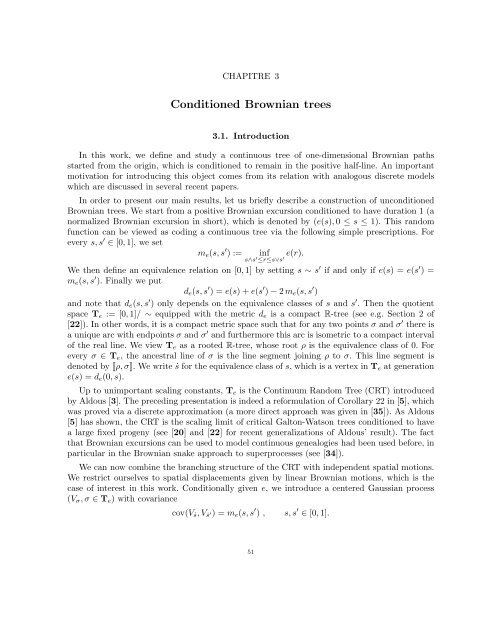arbres aléatoires, conditionnement et cartes planaires - DMA - Ens
arbres aléatoires, conditionnement et cartes planaires - DMA - Ens
arbres aléatoires, conditionnement et cartes planaires - DMA - Ens
Create successful ePaper yourself
Turn your PDF publications into a flip-book with our unique Google optimized e-Paper software.
CHAPITRE 3<br />
Conditioned Brownian trees<br />
3.1. Introduction<br />
In this work, we define and study a continuous tree of one-dimensional Brownian paths<br />
started from the origin, which is conditioned to remain in the positive half-line. An important<br />
motivation for introducing this object comes from its relation with analogous discr<strong>et</strong>e models<br />
which are discussed in several recent papers.<br />
In order to present our main results, l<strong>et</strong> us briefly describe a construction of unconditioned<br />
Brownian trees. We start from a positive Brownian excursion conditioned to have duration 1 (a<br />
normalized Brownian excursion in short), which is denoted by (e(s),0 ≤ s ≤ 1). This random<br />
function can be viewed as coding a continuous tree via the following simple prescriptions. For<br />
every s,s ′ ∈ [0,1], we s<strong>et</strong><br />
m e (s,s ′ ) := inf e(r).<br />
s∧s ′ ≤r≤s∨s ′<br />
We then define an equivalence relation on [0,1] by s<strong>et</strong>ting s ∼ s ′ if and only if e(s) = e(s ′ ) =<br />
m e (s,s ′ ). Finally we put<br />
d e (s,s ′ ) = e(s) + e(s ′ ) − 2m e (s,s ′ )<br />
and note that d e (s,s ′ ) only depends on the equivalence classes of s and s ′ . Then the quotient<br />
space T e := [0,1]/ ∼ equipped with the m<strong>et</strong>ric d e is a compact R-tree (see e.g. Section 2 of<br />
[22]). In other words, it is a compact m<strong>et</strong>ric space such that for any two points σ and σ ′ there is<br />
a unique arc with endpoints σ and σ ′ and furthermore this arc is isom<strong>et</strong>ric to a compact interval<br />
of the real line. We view T e as a rooted R-tree, whose root ρ is the equivalence class of 0. For<br />
every σ ∈ T e , the ancestral line of σ is the line segment joining ρ to σ. This line segment is<br />
denoted by [[ρ,σ]]. We write ṡ for the equivalence class of s, which is a vertex in T e at generation<br />
e(s) = d e (0,s).<br />
Up to unimportant scaling constants, T e is the Continuum Random Tree (CRT) introduced<br />
by Aldous [3]. The preceding presentation is indeed a reformulation of Corollary 22 in [5], which<br />
was proved via a discr<strong>et</strong>e approximation (a more direct approach was given in [35]). As Aldous<br />
[5] has shown, the CRT is the scaling limit of critical Galton-Watson trees conditioned to have<br />
a large fixed progeny (see [20] and [22] for recent generalizations of Aldous’ result). The fact<br />
that Brownian excursions can be used to model continuous genealogies had been used before, in<br />
particular in the Brownian snake approach to superprocesses (see [34]).<br />
We can now combine the branching structure of the CRT with independent spatial motions.<br />
We restrict ourselves to spatial displacements given by linear Brownian motions, which is the<br />
case of interest in this work. Conditionally given e, we introduce a centered Gaussian process<br />
(V σ ,σ ∈ T e ) with covariance<br />
cov(Vṡ,Vṡ′) = m e (s,s ′ ) , s,s ′ ∈ [0,1].<br />
51

















